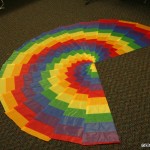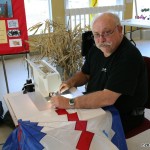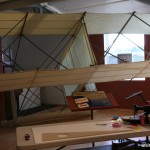Okay, we’re on our way again. This time, it’s Theresa Norelius and I – on our way to a Build-A-Kite Workshop at the World Kite Museum in Long Beach, Washington on that mid-February three-day weekend, “President’s Day Weekend.” And so, a couple of hours on Friday afternoon saw us headed over to Long Beach and checking in at our condo again roughly a month after the last time we’d stayed there. It’s getting so the front-desk staff greets us with a hearty, “What? YOU again?” Yup US again!
And Saturday morning had us up an at ‘em fairly early and in the door over at the Museum a bit before the official 9:00 start. Yes, the Museum’s Director/Curator and the Office manager – Kay Buesing and Sharon Absher respectively – were certainly there to greet all of us. And yes, Sharon got my fees, too!
Naturally, John Freeman – our host, instructor, tutor, and our all-around kite-building “Guru” – has all of the workshop folks running around hither-and yon – setting up this, and gathering that, and picking spots, and setting up their work-areas, and I don’t know what-all (literally). Swell, its almost worse than joining the military. Just walk in the door and you’re already lost! What am I doing here, anyway???
Well, what I’m actually doing is attending my first-ever kite-making workshop. And, almost as a byproduct, I also hope to produce my first-ever kite, too… Though it seems like maybe I’ve bitten off a bit more than I can chew this time… Oh well, no matter. I will just blunder on through like I know what I’m doing and perhaps nobody will notice. So the real question is – why am I subjecting myself (and also subjecting the rest of the attendees) to my shenanigans and my participation in this extraordinary exercise? Ostensibly, I’m there to build a Greger-Bargello Rokkaku – meaning a 5’ tall Rokkaku Kite, designed by Margaret Greger, using the Bargello construction technique. And in reality, I have no idea what all that means… but I’m gonna learn.
John and Marzlie Freeman have been good friends of mine for a while now. They knew I was kinda interested in learning to build a kite. They also knew I even went and bought a decent Pfaff 1475CD sewing machine. And so they’d been hounding me to actually build a kite for a while… and this was as good an opportunity to get “the geezer” (me) involved as any. And believe me, there were plenty of other folks urging me on as well – Theresa Norelius specifically included.
For my own part, however, I had somewhat different reasons for going. As I said to John Freeman, I could boil them down to just three reasons. Since I always approach any event report from my own personal viewpoint anyway, the event report I expect to write will certainly list the three reasons I came to your workshop (I betcha thought it was just for your sunny disposition, ‘eh John?). They are – in priority sequence… 1.) To see what a well-run workshop looks like from the INSIDE! 2.) To meet the kind of folks that go to these events, and understand their particular slant on kiting – and on “kite-building.” 3.) To learn a little bit about kite construction (really “sail-making”) from “The Master,” and maybe even learn to sew enough to build my own kite – someday!
PLEASE NOTE – Any intent to come away having satisfied those three reasons DOESN’T include leaving Long Beach at the end of that weekend with a finished, flyable kite! I want you readers to understand that part! That was NOT a part of my commitment!
So, with a fair amount of trepidation, I’d signed up for John Freeman’s Workshop back in December or early January …and I almost immediately started receiving emails about the workshop. Yes, I actually DID intend to attend. “Sure, send me the information on choices, John.” Another email arrived with photos of four (4) sample kites they had created, and asking for my selections regarding the preferred kite-layout and color scheme for the kite I wanted to build. And, by the time we got to Long Beach, there must have been 8-10 emails from John. Make no mistake about it. John had already been “woking” this project for a couple of months when we arrived in Long Beach.
When we arrived, John was ready with enough “printed Instructions” for everyone. Plus a “Parts kit.” And a bundle of spars to use to build the frame. And a set of machined templates to use. And a bunch of “common” tools, such as layout and cutting mats, spare cutters and hobby knives, straight edges and rulers, and “spares” of this and that – enough so anyone who’d paid their money and arrived in good faith – would have a very fine time building a “project kite” like this one.
Well… When we arrived on Saturday morning, I had my (expected) problems with set-up. Where is everything, and what’s the “drill?” How do I do this – and that – and the other thing? Most all of it was just dealing with my own inexperience. I’d run a couple of lines of stitches through the Pfaff at home just to make sure the machine actually sewed, but that wasn’t going to cut it here. And I had to be “instructed” on where to get fabric, and how to cut it properly, and so forth – while all the beginning chaos of Saturday Morning was going on. Fortunately, I wasn’t dealing with any time pressure at all, so I guessed I would likely fall further behind – which was perfectly okay with me. Nope – I never did catch up. But we all knew that was going to happen going in – right?
But after setting up my “work station” (an exercise in anxiety all by itself), I had to get my “supplies,” which mostly meant cutting fabric off of bolt-rolls. Kind of a no-brainer, right? Uh… NO! They had to be cut PRECISELY correct – otherwise your kite will be a mess – assuming that you can even build one at all if you’ve miss-cut the fabric to begin with. Naturally, at the cutting table upstairs, there were no end of people all trying to do the same thing – and each individual had some slightly different way of doing this “cutting” chore. So – me being the resident “newbie” here – I had about a dozen different options of ways to cut fabric. So both Marzlie Freeman and Theresa Norelius took me aside and explained “how to” (separately), and I combined their techniques into something that seemed to work for me. But cutting fabric is no easy task…
And… I also finally sat at my machine, and attempted to work (sew) on my kite project. Sure, I made my share of mistakes, and I probably had a surplus of problems in that regard too – maybe even enough gaffes to give some away to others, if anyone ran out of their own… Anyway, I DID finally gain some minor expertise… But by the time I left, I also thought seriously about investing in some company that makes “seam rippers” for a living! But I also made sure I could (eventually) learn to sew a straight line, and to diligently follow the directions on the instruction sheets, and in the process, I also learned to believe I could actually produce a flyable kite – eventually!
Now – this will seem long and convoluted, but I’m going to walk you through the multiple steps necessary to produce this kite.
1. Select and cut fabric in various colors, so you have five sets of strips. Sew each set of strips together into a “sheet” and then sew the edges together – making a tube of fabric (done 5 times – for 5 tubes). Cut 24 11” sections of these tubes.
2. Open each tube in sequence adjusting the cut so the now horizontal stripes move away from the top by set amount, so that each band of color “moves” as you create a wedge of fabric. Use a template (provided) to cut the wedges, making 24 wedges.
3. Sew the wedges together, making a circular “sheet” with the wedge-points in the center. Cut and install the center “dot” on this sheet.
4. Lay a (3’ X 4’ X 5’) Rokkaku template on the sheet – moving the template so your kite “looks good,” and then cut out the entire kite sail, trimming off the excess.
5. Edge-finish, install corner pockets and sleeves, frame the kite, cut holes for bridle attachments and install the bridle reinforcements. Bridle the kite and fly it!
6. Yes – there is a TON of sewing on this kite. Yes, there is an excessive amount of fabric used, too – meaning much “scrap.”
Scraps are sort of ready-made shapes for mini-banners, or can be used to create a sleeve for your new Rokkaku, or used in other ways.
So – I sat at my sewing station until I thought I’d go “buggy” with the tedium of all this “detail” work. Then I would just grab the camera and go talk with fellow workshop attendees and shoot a few photos. Yes, I eventually ended up back at my sewing machine, working on my kite.
So, I also studied the people around me a bit. Oh, I already knew about half of the attendees, and I learned 3-4 more names, too – and watched these folks both work and play – often doing both at the same time. Interesting… These workshops are certainly about building a kite, but they’re also about sharing ideas, talking each other through the necessary building-steps, catching errors early while they’re correctable, and also – while we’re at it – socializing a good bit, too. Nice friendly working environment, and an extremely free exchange of ideas and plenty of good humor and kidding between the attendees.
But – lest you think it was all just a “gab fest” – there was a LOT of “kite creation” going on too. John Freeman seemed to be everywhere – checking in on each person’s project, offering a word of encouragement here, and a subtle suggestion there, and occasionally an “Uh-Oh, maybe you need to do it THIS way instead” occasionally, too.
For instance, it was the first time I’d met Sam King face-to-face, and I’d never met Sam before. No, his wife Cari was not in evidence this weekend. He’s a “serious” kite-builder, with a kind and gentle demeanor, and a quiet, off-beat sense of humor. Altogether, a lovely and most gracious man…
Then there were Debbie and Carl Fitzgerald who sat directly in front of my workstation. What a nice couple, though there was frequent back-and-forth kidding and cajoling between them about how to construct this kite. Together, they managed to reach equitable, mutually-agreed construction methods however – and smiled and grinned throughout the entire process.
And Larry Christiansen was over there too, sharing the alcove with Debbie and Carl. He’s mostly kind of quiet – or he was on that weekend anyway. But we all got to laughing when Sam King offered, seemingly out of the blue, “The beatings will continue until morale improves!” And I chimed in, “Oh yeah, I remember that part. ‘There will be NO Liberty until Morale improves’.” So Larry jumped in, immediately wanting to know, “Navy or Coastie?” Well, Larry and I kinda “bonded” with short glances between us over that one (He’s Coast Guard and I’m Navy)… and then we all easily drifted back to our work.
Bob and Donna Wendt were the other folks with us downstairs – along with a very nice, and quite organized seam-stress lady whose name I did not think to get – who was also with us. She even had the good sense to being two sewing machines – one for plain old straight-line sewing, and one she’d specifically set up for top stitching.
And then I’d also go wander up on the second floor to shoot my photos and talk with other fellow attendees, up where the majority of the workshop folks had set up shop.
Upstairs, Jerry Graham and Glenda Kleppin and several other folks were in a room just left off the stairway. Jerry had done major sewing work on his kite before he came to Long Beach, and he worked diligently on his kites whenever I happened by. I’m sure he eventually got home to Bonnie Lake all right, but the last time I saw Jerry, he was still hunched over his machine – sewing away…
And right outside the door to that room, Rod Beamguard was working on TWO kites simultaneously – both of them in Washington State University “Cougar” colors. He was doing quite well too, and the “first” of the pair looked to be a very professional job, and quite striking to look at while the other kite wasn’t quite as far along.
Richard Hurd and Phyllis Gribbin were both working on their kites with a passion. Richard’s a real work-horse when it comes to building kites anyway, and I think Phyllis has bought into Richard’s work-ethics so they were both doing very well with their creations… I also suspect that they looked at this outing as just a tune-up for their “big event” – Richard had won the scholarship to the Fort Worden Kite-Builders Conference this year, so they needed to get used to building kites quickly.
Rob Pratt was also upstairs, and Rob was the first kite-maker finished with his kite as far as I know – finishing sometime early on Sunday afternoon.
And Al Councilman and Theresa Norelius both had a couple of “hitches” and back-tracks during construction but continued working on their kites.
Meanwhile the Fitzgeralds got to the “piece it together” part, and discovered it wouldn’t work as designed. Oh well, stick a strip in between the wedges and “sew away” was their solution, and their kite looked very nice when held up against the window for a “color” check.
And, if you think MY progress amounted to “not very much,” I need only remind you of two things. I was here for different reasons than producing the “first” kite, or even producing the “best” kite, or for that matter – actually producing any kite at all. So, in that regard, I actually exceeded my goals on that score. I now believe “I can do it.” My goals after the workshop ended, were to take the instructions and the materials home, and “produce a finished kite – sometime!” Therefore – I am still “on track.” And my second goal was to learn about the “people” in these workshops – mostly by jumping in over my head and yakking with them. They are superb, each and every one that I ran into… bar NONE!
You are correct, Master-Kitebuilder Freeman. It was downright FUN! Oh, I can grumble about the time it takes to do this or that… Or how many “fumble fingers” it takes to rip a seam, or sew one properly for that matter – when you have no expertise. But the overall impression I received was one of “Fun,” coupled with an good “guided instruction” in a sewing technique that was new to most folks. The fact that I had NO sewing technique to begin with certainly made MY time there more difficult (never mind my OWN perhaps “misguided” priorities?), but I will venture to say that I probably learned as much as anyone else who was there, and certainly more than most. I just learned different, more basic, stuff about kite-building. Well, about kite SEWING anyway. After all, “Sail-Making” is about the only part of kite-making that I haven’t done a fair amount of.
So, finally – how’d my own priorities work out?
1. What does a well-run workshop look like from the behind the curtain?
Well, to start with, this one WAS a well thought-out, well organized, and well-run affair. If I’d had the skills I probably should have had before I stepped in the door, I would have done much better. And had I applied myself to the “task at hand” instead of my own priorities, I’d have gone a good way towards completion.
2. To meet and understand the kind of folks that go to these workshops, and their slant on “kite-building.
These folks are serious about building kites, and also just delighted to be there. They look at these workshops as a chance to actually create something, learn new skills, and to gather with their favorite kiter friends. VERY worthwhile!
3. To learn a little bit about kite construction (really “sail-making”).
Yes, I did it. A sewing machine doesn’t scare me much anymore. Oh, I have LOTS to learn there, and I maybe even aught to take a lesson or two, but the fear is pretty much gone. And – YES – I will finish this kite “sometime” in the not too distant future.
All in all, this is just like all the rest of kiting, at least as far as I know it. A whole bunch of extra-nice folks, hanging out together, and playing with kites. Lots of creativity, lots of gentle humor, and loads of work too!
And as John Freeman wrote to me in a post-workshop email:
Many folks express thanks for me doing these things. I think what they forget is that my motto is, “if it ain’t fun, I don’t do it.” No thanks required for having this much fun!
Well, John – I think that same concept applies to all of us who attended. And, maybe even to Kite-Building Workshops all over the country, too. I hope they are all as productive, creative, and FUN – as the one we all experienced.
Fair Winds and Good Friends –
geezer




























